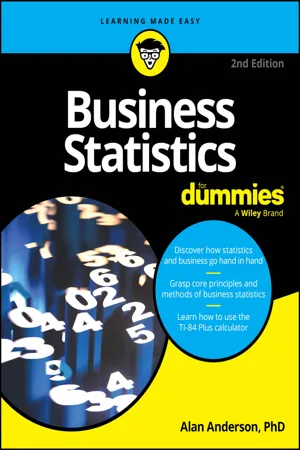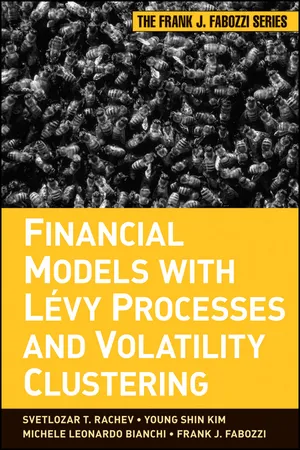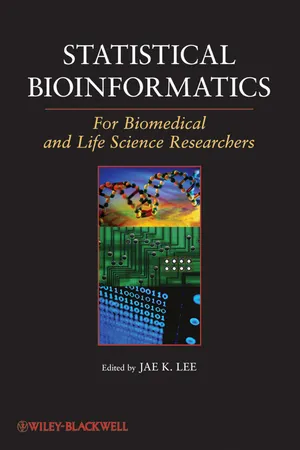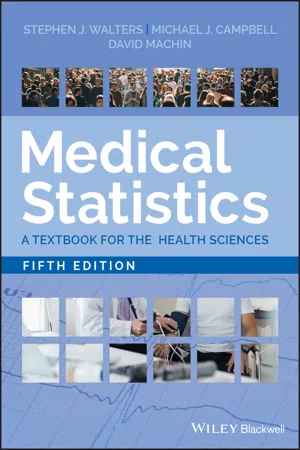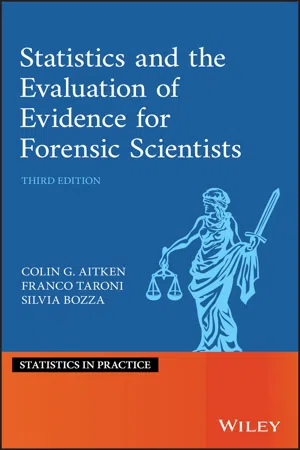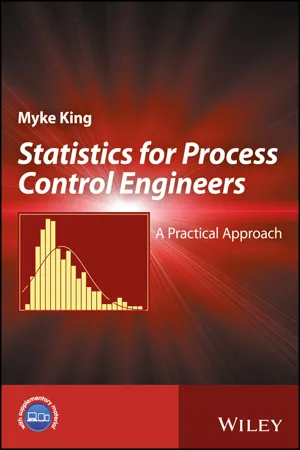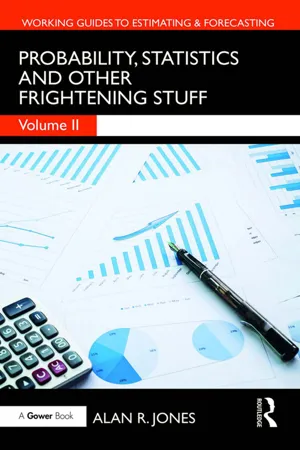Mathematics
Probability Distribution
A probability distribution in mathematics is a function that describes the likelihood of different outcomes in a sample space. It assigns probabilities to each possible outcome, allowing for the calculation of expected values and the assessment of uncertainty in a given scenario. Probability distributions are fundamental in statistical analysis and are used to model random variables and events.
Written by Perlego with AI-assistance
Related key terms
10 Key excerpts on "Probability Distribution"
- eBook - ePub
- Alan Anderson(Author)
- 2023(Publication Date)
- For Dummies(Publisher)
You can model many complex business problems by using Probability Distributions. These distributions help provide answers to questions such as, “What’s the likelihood that oil prices will rise during the coming year?” “What’s the probability of a stock market crash next month?” “How likely is it that a corporation’s earnings will fall below expectations this year?”A Probability Distribution defines the statistical properties of a variable. Accurate modeling of financial variables requires that you pick the appropriate distribution for a given situation. Two of the more widely used Probability Distributions in business are the binomial and Poisson distributions. These are examples of discrete distributions, in which only a countable number of values are possible.This chapter covers the key properties of the binomial and Poisson distributions and explains the circumstances under which you may apply them. For each distribution, I give you formulas for computing probabilities and also provide tables as alternatives to doing the computing yourself. This chapter also introduces summary measures of Probability Distributions, known as moments, which are closely related to the mean, variance, and standard deviation of samples and populations (described in Chapters 3 and 4 ). Then I wrap up the chapter by covering simplified formulas for computing the moments of the binomial and Poisson distributions.Looking at Two Possibilities with the Binomial Distribution
You use the binomial distribution - Svetlozar T. Rachev, Young Shin Kim, Michele L. Bianchi, Frank J. Fabozzi(Authors)
- 2011(Publication Date)
- Wiley(Publisher)
6 When a random variable is either the price of or the return on a financial asset or an interest rate, the random variable is assumed to be continuous. This means that it is possible to obtain, for example, a price of 95.43231 or 109.34872 and any value in between. In practice, we know that financial assets are not quoted in such a way. Nevertheless, there is no loss in describing the random variable as continuous and in many times treating the return as a continuous random variable means a substantial gain in mathematical tractability and convenience.For a continuous random variable, the calculation of probabilities works substantially differently from the discrete case. The reason is that if we want to derive the probability that the realization of the random variable lays within some range (i.e., over a subset or subinterval of the sample space), then we cannot proceed in a similar way as in the discrete case: The number of values in an interval is so large, that we cannot just add the probabilities of the single outcomes. The new concept needed will be explained in the next section.2.3.1 Probability Distribution Function, Probability Density Function, and Cumulative Distribution FunctionAProbability Distribution function Passigns a probability P (A ) for every event A , that is, of realizing a value for the random value in any specified subset A of the sample space. For example, a Probability Distribution function can assign a probability of realizing a monthly return that is negative or the probability of realizing a monthly return that is greater than 0.5% or the probability of realizing a monthly return that is between 0.4% and 1.0%.To compute the probability, a mathematical function is needed to represent the Probability Distribution function. There are several possibilities of representing a Probability Distribution by means of a mathematical function. In the case of a continuous Probability Distribution, the most popular way is to provide the so-called probability density function or simply density function .In general, we denote the density function for the random variable X as f (x ). Note that the lowercase X is used. This is the convention adopted to denote a particular value for the random variable. The density function of a Probability Distribution is always non-negative and as its name indicates: Large values for f (x ) of the density function at some point x imply a relatively high probability of realizing a value in the neighborhood of x , whereas f (x ) = 0 for all x in some interval (a, b ) implies that the probability for observing a realization in (a, b- eBook - ePub
Statistical Bioinformatics
For Biomedical and Life Science Researchers
- Jae K. Lee(Author)
- 2011(Publication Date)
- Wiley-Blackwell(Publisher)
Bootstrap Methods and Their Application by D. V. Hinkley and A. C. Davison, Cambridge University Press, New York, 1997.2.10 SUMMARYThis chapter reviews basic ideas of probability, random variables, Probability Distributions, and sampling distributions of a statistic. The axiomatic approach is followed to define probabilities of events in a sample space, which is the collection of all possible outcomes of an experiment. When the outcomes are equally likely, the probability of an event is just the ratio of the number of outcomes in the event to the number of outcomes in the sample space.The conditional probability of an event A given that an event B has occurred, P(A | B), defined as P(A ∩ B)/P(B). Events A and B are independent if P(A ∩ B) = P(A)P(B). The Bayes theorem forms an important basis of a Bayesian statistics as a reexpression of the conditional probability formula to find P(B | A) in terms of P(A | B), P(A), and P(B).A r.v. X assigns a unique numerical value x to each outcome in the sample space. Random variables are classified as discrete or continuous. The Probability Distribution of a discrete or continuous r.v. is given by its p.m.f. f(x) = P(X = x) or p.d.f. for all values x. The p.d.f. of a continuous r.v. has the property that P(a ≤ X ≤ b) is given by the area under the p.d.f. curve between a and b for any interval [a, b]. The c.d.f., defined as F(x) = P(X ≤ x) for all x , unifies these two concepts.The mean or the expected value is useful for summarizing a symmetrically distributed r.v. X ; that is, the mean, E(X ) = µ , is a measure of the center of the distribution, and the variance,σ2 =E [(X – µ )2 ], is a measure of dispersion of the distribution about its mean.The above concepts can be generalized to two (or more) r.v.’s, say, X and Y . The joint Probability Distribution (p.d.f. or p.m.f.) of X and Y is denoted by f(x, y) . The marginal distribution g(x) of X is just the p.m.f. (or p.d.f.) of X , which is obtained by summing (or integrating) f(x, y) over y for fixed x . The covarianceσXY =E [(X –µX )(Y – µY )]of X and Y measures their joint dispersion from their respective means. The correlation coefficientpXYstandardizes the covariance to the range [ – 1, +1]. Both are measures of the linear relationship between X and Y . This concept can be generalized to more than two r.v.’s, say, X 1 , . . . ,Xn - eBook - ePub
Medical Statistics
A Textbook for the Health Sciences
- Stephen J. Walters, Michael J. Campbell, David Machin(Authors)
- 2020(Publication Date)
- Wiley-Blackwell(Publisher)
4 Probability and Distributions- 4.1 Types of Probability
- 4.2 The Binomial Distribution
- 4.3 The Poisson Distribution
- 4.4 Probability for Continuous Outcomes
- 4.5 The Normal Distribution
- 4.6 Reference Ranges
- 4.7 Other Distributions
- 4.8 Points When Reading the Literature
- 4.9 Technical Section
- 4.10 Exercises
Summary
Probability is defined in terms of either the long‐term frequency of events, as model based or as a subjective measure of the certainty of an event happening. Examples of each type are given. The concepts of independent events and mutually exclusive events are discussed. Several theoretical statistical distributions, such as the Binomial, Poisson and Normal are described. The properties of the Normal distribution and its importance are stressed and its use in calculating reference intervals is also discussed.4.1 Types of Probability
There are a number of ways of looking at probability and we describe three as the ‘frequency’, ‘model‐based’ and ‘subjective’ approaches as shown in Figure 4.1 .Three types of probability.Figure 4.1We all have an intuitive feel for probability but it is important to distinguish between probabilities applied to single individuals and probabilities applied to groups of individuals. In recent years about 600 000 people die annually from about 65 million people in the United Kingdom. Hence, for a single individual, with no information about their age or state of health, the chance or probability of dying in any particular year is 600 000/65 000 000 = 0.009 or just under 1 in 100. This is termed the crude mortality rate as it ignores differences in individuals due, for example, to their gender or age, which are both known to influence mortality. From year‐to‐year this probability of dying is fairly stable (see Figure 4.2 - Amit Kumar Gorai, Snehamoy Chatterjee(Authors)
- 2022(Publication Date)
- CRC Press(Publisher)
2 Basics of probability and statistics DOI: 10.1201/9781003200703-2 2.1 Definition of probability Probability is defined as the chances of occurrence of any event in an experiment. The sum of all the possible outcomes is called the sample space, and a subset of sample space is known as an event. If there are S exhaustive (i.e., at least one of the events must occur), mutually exclusive (i.e., only one event occurs at a time), and equally likely outcomes of a random experiment (i.e., equal chances of occurrence of each event) and r of them are favourable to the occurrence of an event A, the probability of the occurrence of the event A is given by P (A) = r S (2.1) It is sometimes expressed as ‘odds in favour of A ’ or the ‘odds against A ’. The ‘odds in favour of A ’ is defined as the ratio of occurrence of event A to the non-occurrence of event A. On the other hand, ‘odds against A ’ is defined as the ratio of non-occurrence of event A to the occurrence of. event A Odds in favour of A = P r o b a b i l i t y o f o c c u r r e n c e o f e v e n t A P r o b a b i l i t y o f non-occurrence o f e v e n t A = r / S (S − r) / S = r S − r Again, Odds against A[--=PLGO-SEPARATOR. =--]= P r o b a b i l i t y o f non-occurrence o f e v e n t A P r o b a b i l i t y o f o c c u r r e n c e o f e v e n t A = (S − r) / S r / S = S − r r The total probability of the occurrence of any event ranges from 0 to. 1. i.e., 0 ≤ P (A) ≤ 1 P (A) = 0 indicates event A is impossible, and P (A) = 1 indicates the event is certain. In the above discussion, the discrete sample space was considered. But, the probability can also be determined for a continuous sample space. For a continuous sample space, the probability of occurrence is measured as a probability density function. The probability density function of any continuous random variable gives the relative likelihood of any outcome in a specific range- Colin Aitken, Franco Taroni, Silvia Bozza(Authors)
- 2020(Publication Date)
- Wiley(Publisher)
A Probability Distributions A.1 Introduction Various Probability Distributions have been mentioned in the course of the book. They are summarised here in the Appendix for ease of reference with a few examples to aid understanding. In certain general circumstances the way in which probability is distributed over the possible numbers of counts or values for the measurements can be represented mathematically, by functions known as Probability Distributions. Distributions for counts and for measurements will be described in Sections A.2 and A.3, respectively. Further details of many of the distributions mentioned here and others may be found in Forbes et al. (2010) or in Wikipedia. Before Probability Distributions can be discussed here, however, certain other concepts have to be introduced. A characteristic of interest from a population is known as a parameter. The corresponding characteristic from a sample from the population is known as an estimate. For example, the proportion of Caucasians in Chicago with allele AA at locus LDLR is a parameter. The proportion of Caucasians with allele AA at locus LDLR in the sample of 200 people studied by Johnson and Peterson (1999) is an estimate of. Conventionally a symbol (read as ‘hat’) is used to denote an estimate. Thus (read as ‘gamma‐hat AA’) denotes an estimate of. From Table 1.1,. Another notational convention, as well as the notation, is to use Roman letters for functions evaluated from counts or measurements from samples and Greek letters for the corresponding parameters from populations. Thus given a sample of size from a population with measurements, the sample mean is, which may be summarised as and denoted (read as ‘ x ‐bar’). The corresponding population mean is denoted with a Greek letter, e.g.. A sample standard deviation may be denoted and for the sample an estimate of the standard deviation is the square root of. The corresponding population standard deviation is often denoted- eBook - ePub
Statistics for Process Control Engineers
A Practical Approach
- Myke King(Author)
- 2017(Publication Date)
- Wiley(Publisher)
5 Probability Density FunctionThe probability density function (PDF) is a mathematical function that represents the distribution of a dataset. For example, if we were to throw a pair of unbiased six‐sided dice 36 times, we would expect (on average) the distribution of the total score to be that shown by Figure 5.1 . This shows the frequency distribution. To convert it to a Probability Distribution we divide each frequency by the total number of throws. For example, a total score of 5 would be expected to occur four times in 36 throws and so has a probability of 4/36 (about 0.111 or 11.1%). Figure 5.2 shows the resulting Probability Distribution.Expected frequency of total score from two diceFigure 5.1Expected distributionFigure 5.2Throwing dice generates a discrete distribution; in this case the result is restricted to integer values. Probability should not be plotted as continuous line. The probability of a non‐integer result is zero. But we can develop an equation for the line. In this case, if x is the total scored, the probability of scoring x is(5.1)Because x is discrete this function is known as the probability mass function (PMF). If the distribution were continuous we can convert the Probability Distribution to a probability density function (PDF) by dividing the probability by the range over which it applies.A condition of both functions is that the area they contain must be unity (or 100%) – in other words we are certain to be inside the area. So, in general(5.2)Provided this condition is met then any function can be described as a PDF (or PMF). We will show later that there are many functions that have a practical application. Unfortunately there are a larger number that appear to have been invented as a mathematical exercise and are yet to be shown that they describe any real probability behaviour.While the PMF allows us to estimate the probability of x having a certain value, the PDF does not. It only tells us the probability of x falling within a specified range. The probability of x being between a and b - eBook - ePub
- James E. Breneman, Chittaranjan Sahay, Elmer E. Lewis(Authors)
- 2022(Publication Date)
- Wiley(Publisher)
Finally, the median value is defined as that value x = x n for which the probability of obtaining a smaller value is 1/2: (2.27) Example 2.18 A discrete Probability Distribution is given by Determine A. What is the probability that x ≤ 3? What is μ ? What is σ ? Solution: (a) From Eq. (2.21) : Figure 2.14 Discrete Probability Distribution: (a) probability mass function (PMF) and (b) the corresponding cumulative distribution function (CDF). (b) From Eqs. (2.22) and (2.23) : (c) From Eq. (2.25) : (d) Using Eq. (2.26), First, Then, The idea of the expected value is an important one. In general, if there is a function g (x n) of the random variable x, the expected value E (g) is defined for a discrete random variable as (2.28) Thus, the mean and variance given by Eqs. (2.22) and (2.23) may be written as (2.29) (2.30a) or (2.30b) The quantity is referred to as the standard deviation of the distribution. The notion of expected value and variance is also applicable to the continuous random variables discussed in the following chapter. The Binomial Distribution The binomial distribution is the most widely used discrete distribution in reliability engineering. To derive it, suppose that p is the probability of failure for some piece of equipment in a specified test and (2.31) is the corresponding success (i.e. nonfailure) probability. If such tests are truly independent of one another, they are referred to as Bernoulli trials. A discrete random variable is a Bernoulli trial if it can take on only the values zero and one. Bernoulli random variables are used to model events having two possible outcomes. For example: Coin toss (p = 0.5, q = 0.5) O‐ring failure on Space Shuttle Solid Rocket booster (p = 0.04, q = 0.96) In summary, a series of Bernoulli trials, each independent of the other trials, and each having the same probability of success, makes up a binomial distribution - Aliakbar Montazer Haghighi, Dimitar P. Mishev(Authors)
- 2013(Publication Date)
- Wiley(Publisher)
i = 1, 2, … , then, by the third axiom of probability, A3, we will have:(1.4.1)For a random variable, X, defined on a continuous sample space, Ω, the probability associated with the sample points for which the values of X falls on the interval [a, b] is denoted by P(a ≤ X ≤ b).Definition 1.4.11
Suppose the function f(x) is defined on the set of real numbers, , such that f(x) ≥ 0, for all real x, and . Then, f(x) is called a continuous probability density function (pdf) (or just density function) on and it is denoted by, fX (x). If X is a random variable that its probability is described by a continuous pdf as:(1.4.2)then X is called a continuous random variable. The Probability Distribution function of X, denoted by FX (x), is defined as:(1.4.3)Notes:
1. There is a significant difference between discrete pdf and continuous pdf. For a discrete pdf, fX = P(X = x) is a probability, while with a continuous pdf, fX (x) is not a probability. The best we can say is that fX (x)dx ≈ P(x ≤ X ≤ x + dx) for all infinitesimally small dx.2. If there is no fear of confusion, we will suppress the subscript “X” from fX (x) and FX (x) and write f(x) and F(x), respectively.As it can be seen from (1.4.3) , distribution function can be described as the area under the graph of the density function.Note from (1.4.2) and (1.4.3) that if a = b = x, then:(1.4.4)What (1.4.4) says is that if X is a continuous random variable, then the probability of any given point is zero. That is, for a continuous random variable to have a positive probability, we have to choose an interval.Notes:
(a) From (1.4.4) , we will have:(1.4.5)(b) Since by the fundamental theorem of integral calculus, fx (x) = dFx (x)/dx, the density function of a continuous random variable can be obtained as the derivative of the distribution function, that is, . Conversely, the cumulative distribution function can be recovered from the probability density function with (1.4.3)- Alan Jones(Author)
- 2018(Publication Date)
- Routledge(Publisher)
In any situation where we can identify the upper and lower limits of a variable, but cannot say whether any particular value is more of less likely to occur than another, then we should consider it to be Uniformly Distributed. For example, we may have good reason to think that a task will take a minimum of two weeks to perform and no longer than five weeks, but with the knowledge we have at our disposal we cannot say in all honesty that any particular value (say 3.5 weeks) is any more likely a duration than any other value between two and five weeks. In these circumstances, we should be thinking from an estimate or scheduling perspective using a Uniform Distribution.The Standard Continuous Uniform Distribution is used to generate the random probability of a value occurring for a variable in Monte Carlo Simulation. This uniformly distributed random variable is then used to map across to the assigned distribution for the variable. This process is discussed more fully in Volume V Chapter 3 on Monte Carlo Simulation.4.3.5 Key stats and facts about the Uniform DistributionFor the Formula-philes: Key Stats and Facts about the Uniform Distribution4.4 Binomial and Bernoulli Distributions
4.4.1 What is a Binomial Distribution?The Binomial Distribution is a discrete Probability Distribution that calculates the probability of getting a number of successes from a number of independent events where each event has the same chance (i.e. probability) of success. We can liken it to a set of switches that are either on or off.For instance, suppose we have three coins and we want to know the odds (probability) of tossing two ‘heads’. Each toss has an equal chance, 50%, of being a ‘head’. All the possible outturns are listed in Table 4.3 , there are eight different permutations of ‘heads’ and ‘tails’ leading to four unique combinations.Whilst working out every combination is easily done in cases like this one it becomes a lot more impractical to do so when we are considering a larger number of independent events, especially with an unequal success or fail probability. For instance, suppose we are throwing five dice and we want to know the probability of getting five threes (Why three? No reason other than everyone seems to pick six, so let’s be different! It doesn’t matter which number we pick.) The chance of throwing a three on any one die is one in six. Applying this to each of five dice throws: 6 x 6 x 6 x 6 x 6 = 7,776 possible combinations. This is where the Binomial Distribution will do the work for us, as illustrated in Figure 4.13
Index pages curate the most relevant extracts from our library of academic textbooks. They’ve been created using an in-house natural language model (NLM), each adding context and meaning to key research topics.
